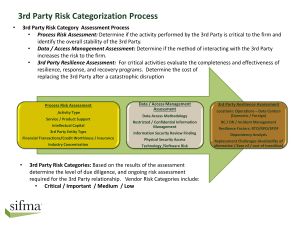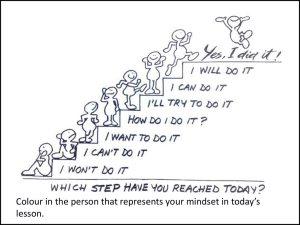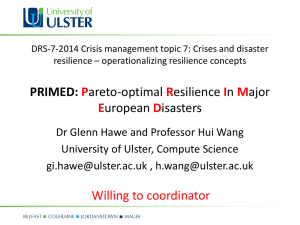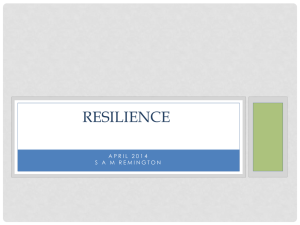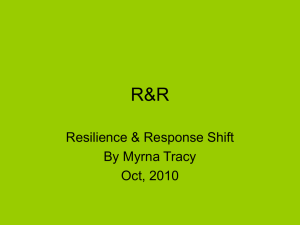Resilience pdf slides
advertisement
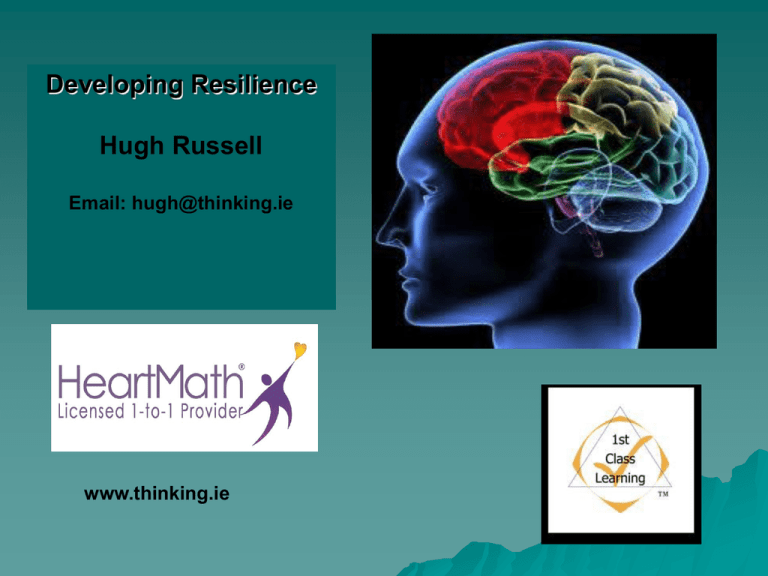
Developing Resilience Hugh Russell Email: hugh@thinking.ie www.thinking.ie Objectives By the end of the workshop you will be able to - define resilience and explain it's link with emotional intelligence identify and explain the 7 factors of resilience explain the relationship between cognition and emotions define and apply several NLP techniques/strategies to build resilience Apply techniques to - change negative thinking - create a mentally tough mindset - be outcome oriented - demonstrate resilience to others - help others through challenging times What is RESILIENCE? What is resilience? What does it mean in your workplace? What does it mean in your life? If you were to develop strong and effective resilience strategies what outcome(s) would that get for you? Resilience Our ability to remain healthy, energetic, at full capacity & in problem solving mode for as long as possible, and as long as necessary. What is Resilience? Keys to staying Resilient Our ability to remain healthy, energetic, at full capacity & in problem solving mode for as long as possible and as long as necessary. Managing you thinking, your emotions and taking action are the keys. The Key to Resilience The empirical research also demonstrates that More than genetics………….. More than intelligence………. More than any other factor….. It is our THINKING That determines who is resilient and who is not How does your mind work? Thinking and Resilience Our thinking creates reflexive beliefs about ourselves, our worlds, and our future. Our thinking provide us with ready-made and often inaccurate beliefs about the causes and implications of our problems. Thinking Styles interfere with accurate problem solving and therefore, resilience. Thinking Style becomes fixed around age 10, learned from primary carer. You experience pictures sounds feelings You talk to yourself Emotional State PHYSIOLOGY You filter out lots of information PERFORMANCE I N F O R M A T I O N Deletion, Distortion & Generalisation Deletions: Important information is left out and this limits thought and action. Distortions: Information is twisted in a way that limits choice and creates unnecessary problems Generalisations: One example is taken to represent a class in a way that narrows possibilities Bias & attitude A bias is our internal, subjective perception of reality. An attitude is the way we habitually think under any given situation. Conscious Mind Unconscious Mind How to talk to the unconscious mind so that it listens Words for the unconscious mind Try But And Don’t Try Statement A “I will try to be less aggressive” Statement B “I will listen more and respond rather than react ” Banish the word “try” from your vocabulary unless you actually want not to succeed But, and Statement A “You focussed well today “but” your concentration faded a little near the end” Statement B “You focussed well today and you need to maintain your concentration to the end” Statement C “ “Yes we did not have a clear focus today, but given the preparation…” Use words like “but”, “however” only when you want to negate or minimise what has been said. Use “and” when you want to add to or agree with what has been said Don’t Statement A “Don’t think negatively. Don’t be thinking that” Statement B “Tell me what you want specifically ” Statement c “Don’t listen to what your critics are saying” Statement D “Ignore your critics. Remember how you presented last week” Misconception that Practice makes Perfect – Practice makes Permanent. Only Perfect Practice makes Perfect, and that can always happen in the mind & in the way we talk to ourselves. The 7 Factors of Resilience Emotional Regulation Impulse Control Causal Analysis Self-Efficacy Realistic Optimism Empathy Reaching Out 7 Factors of Resilience Factor 1- Emotion Regulation – Ability to control our emotional response to external events-to stay calm under pressure. Factor 2- Impulse Control – Ability to control expression behaviour to achieve goals (Delay gratification, Decisions, Dan Goleman 1970 marshmallow study) How do you set your Emotional thermostat? Understanding your emotional map Emotions are contagious The brain has an ‘open loop’ system We are ‘wired’ to pick up subtle clues from one another The Heart The source of the heartbeat is within the heart. It generates 40 to 60 times more electrical amplitude than the brain. Its electrical signal can be measured anywhere on the body. Cortical Facilitation/Inhibition Communication between heart & brain takes place constantly. Positive or negative emotions felt, impact the cortical process. Develop emotional energy management Quick coherence technique Shift attention to your heart & breathe from your heart. Recall a positive emotional experience. Associate into it. Re-experience it for 5 to 10 minutes. See, hear & feel it. Achieve coherence before making decisions Factors of Resilience Factor 3- Causal Analysis – Ability to identify the true causes of an adversity, essential because the cause we identify determine the solutions we attempt – We develop a thinking style around explanations ABC Model Beliefs Adversity About what caused it Any problem situation (big or small) About the implications Consequences Emotions and behaviour that result from Beliefs about adversity B-C Connections Real-world loss or loss of sense of self worth Future Threat Violation of Rights Violation of another's Rights Loss of Standing Sadness (Depression) Anxiety Anger Guilt Embarrassment Resilience Skill: ABC A-Adversity, B-Beliefs, C-Consequences-(feelings and behaviours) – Track the effects of your beliefs on your emotions – Understand the B-C connections. – Become aware of your own! – Help identify the ABC in other people! Detecting iceberg beliefs Four questions Ask in any order Stop when the belief explains the consequence. What is the most upsetting part of that for me? What does that mean to me? What is the worst part of that for me? Assuming that it is true why is that so upsetting for me? Disputation Evidence: What evidence do I have for thinking this? Alternatives: What alternative explanations could there be for this? Implications: What are the implications for me of holding onto this belief? Usefulness: How useful is it for me to hold onto this belief? Thinking Biases Jumping to conclusions Tunnel vision Mind reading Personalising Externalising Over generalising Check for thinking biases Check for thinking biases Distraction Disputation Surface and iceberg beliefs Belief Consequence Adversity Factors of Resilience Factor 4- Self-Efficacy – Our sense that we are effective in the world- a sense of mastery. An outcome orientation. Factor 5- Realistic Optimism – Importance of the cognitive triad, negative view of one’s self, one’s world and one’s future. Mindsets Be clear on what you want (outcome focused) do not be problem focused Have a “cause” mindset. Blaming external influences is counter productive Building Mental pictures of success Dissociated pictures: Looking at yourself as if in a movie Associated pictures: seeing out your eyes Practice Realistic Optimism Explanatory style. – Is unique to you. – Habitual & automatic. – May not be accurate. – There are 3 dimensions to it. Explanatory style: optimism Personal Permanent Pervasive Explanatory Thinking Style ME NOT ME ALWAYS NOT ALWAYS EVERYTHING NOT EVERYTHING Factors of Resilience Factor 6- Empathy – Ability to read others psychological and emotional states, key to developing empathy is understanding why others respond/react as they do. (B-C connections) Factor 7- Reaching Out Helping, listening and rapport building. Seeking help from others. Rapport Rapport is the process of building and sustaining a relationship of mutual trust, harmony and understanding. This happens through matching the accessing cues from words, eye movements and body language. Establish Rapport by… Matching person & mirroring the other –Physical mirroring/Body posture –Voice –Breathing –Blinking –Language 5 Key Strategies 1. 2. 3. 4. 5. Always think in positive outcomes – see, hear and feel what you want. Use both associated and disassociated pictures. Take positive action and challenge yourself to stay at the cause side of events. Check for thinking biases and dispute or distract yourself. Practice realistic optimism. Develop heart coherence, practice mindfulness and “soak” yourself in experiencing positive emotions. Nourish others by becoming a nourishing individual remembering you are “emotionally contagious.” Thank you for coming



